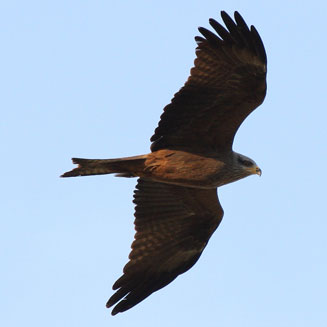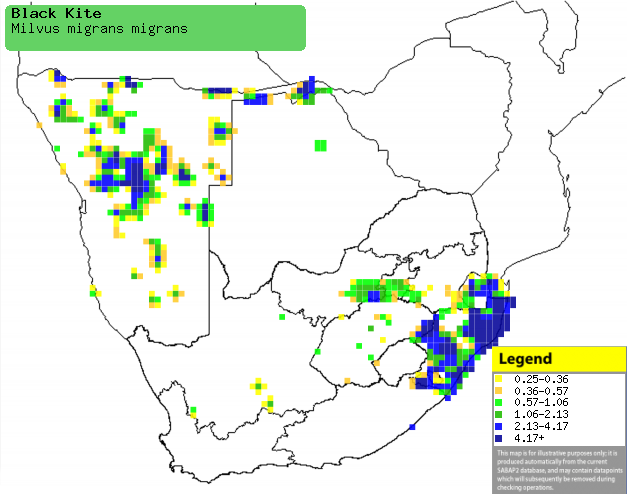|
Milvus migrans (Black
kite)
[= Milvus (migrans) migrans]
Geelbekwou, Swartwou [Afrikaans]; Zwarte wouw [Dutch];
Milan d'Afrique [French]; Schmarotzermilan [German]; Milhafre-preto
[Portuguese]
Life
> Eukaryotes >
Opisthokonta
> Metazoa (animals) >
Bilateria >
Deuterostomia > Chordata >
Craniata > Vertebrata (vertebrates) > Gnathostomata (jawed
vertebrates) > Teleostomi (teleost fish) > Osteichthyes (bony fish) > Class:
Sarcopterygii (lobe-finned
fish) > Stegocephalia (terrestrial
vertebrates) > Tetrapoda
(four-legged vertebrates) > Reptiliomorpha > Amniota >
Reptilia (reptiles) >
Romeriida > Diapsida > Archosauromorpha > Archosauria >
Dinosauria
(dinosaurs) > Saurischia > Theropoda (bipedal predatory dinosaurs) >
Coelurosauria > Maniraptora > Aves
(birds) > Order: Falconiformes
> Family: Accipitridae
 |
|
|
Black kite (part of a large migratory flock), near
Ciudad Real, Spain. [photo
Mike Grimes ©] |
|
Distribution and habitat
It breeds across much of Eurasia, heading south in the
non-breeding season to Madagascar and sub-Saharan Africa. In southern Africa it
occurs in patches of Namibia, northern Botswana and South Africa,
generally preferring woodland habitats.
|
 |
|
Distribution of Black kite in southern Africa,
based on statistical smoothing of the records from first SA Bird Atlas
Project (©
Animal Demography unit, University of
Cape Town; smoothing by Birgit Erni and Francesca Little). Colours range
from dark blue (most common) through to yellow (least common).
See here for the latest distribution
from the SABAP2. |
Movements and migrations
Palearctic breeding migrant, arriving in southern Africa at
the start of the rains in October or November. It leaves just before the end of
the rainy season, in March.
Food
It eats a wide variety of animals, typically searching for
prey aerially; it uses the style of flight characteristic of kites, as it
swivels its tail horizontally to steer accurately. Once it spots something, it
rapidly swoops to the ground to catch the prey item. The Black kite and the
Yellow-billed kite can be grouped as one species, so the following list of
food items in its diet applies for both of them:
- Live prey
- birds
- rodents (Rodentia)
- lizards
- frogs
- Pyxicephalus adspersus (Bullfrog)
- Ptychadena supercilliaris (Savanna ridged frog)
- fish (caught in shallow water)
- molluscs
- crustaceans
- insects
- Scavenged animals
Threats
Not threatened.
References
-
Hockey PAR, Dean WRJ and Ryan PG 2005. Roberts
- Birds of southern Africa, VIIth ed. The Trustees of the John Voelcker
Bird Book Fund, Cape Town.
|
